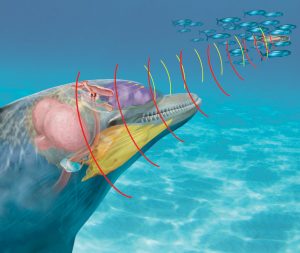Sonar – Part 4
 In recent months we have been discussing echolocation in animals. This month we come to the marvelous use of this navigation technique in water…true sonar. Sound travels 5X faster in water than in air, making it particularly useful for whales and dolphins These mammals echolocate via a specialized organ called the dorsal bursae, which sits atop their head, close to the blowhole. They send out a “sonar beam” that allows them to navigate, even in complete darkness. A fat deposit in this area, called the melon, decreases impedance, or resistance to soundwaves, making the sound clearer. This is what gives them their prominent “forehead.” Another fat deposit, stretching from a whale’s lower jaw up to its ear, clarifies the echo that returns from prey, such as fish or squid. Because of their size and environmental requirements, dolphin sonar research has progressed slower than bat echolocation. In the 1970s the US Military began studying dolphins in Hawaii, attempting to improve their own sonar functionality. They found these amazing animals could distinguish between balls filled with water and those filled with oil. They can differentiate between two metal cylinders that differ by a hair’s width. In one pulse, they could find items buried under feet of sediment, something our best sonar can’t do! All of this amazing functionality was conceived in the mind of our great God and created on Day 5: “And God created great whales, and every living creature that moveth, which the waters brought forth abundantly” (Genesis 1:21).
In recent months we have been discussing echolocation in animals. This month we come to the marvelous use of this navigation technique in water…true sonar. Sound travels 5X faster in water than in air, making it particularly useful for whales and dolphins These mammals echolocate via a specialized organ called the dorsal bursae, which sits atop their head, close to the blowhole. They send out a “sonar beam” that allows them to navigate, even in complete darkness. A fat deposit in this area, called the melon, decreases impedance, or resistance to soundwaves, making the sound clearer. This is what gives them their prominent “forehead.” Another fat deposit, stretching from a whale’s lower jaw up to its ear, clarifies the echo that returns from prey, such as fish or squid. Because of their size and environmental requirements, dolphin sonar research has progressed slower than bat echolocation. In the 1970s the US Military began studying dolphins in Hawaii, attempting to improve their own sonar functionality. They found these amazing animals could distinguish between balls filled with water and those filled with oil. They can differentiate between two metal cylinders that differ by a hair’s width. In one pulse, they could find items buried under feet of sediment, something our best sonar can’t do! All of this amazing functionality was conceived in the mind of our great God and created on Day 5: “And God created great whales, and every living creature that moveth, which the waters brought forth abundantly” (Genesis 1:21).
Posted on February 1, 2023 by dwoetzel.
